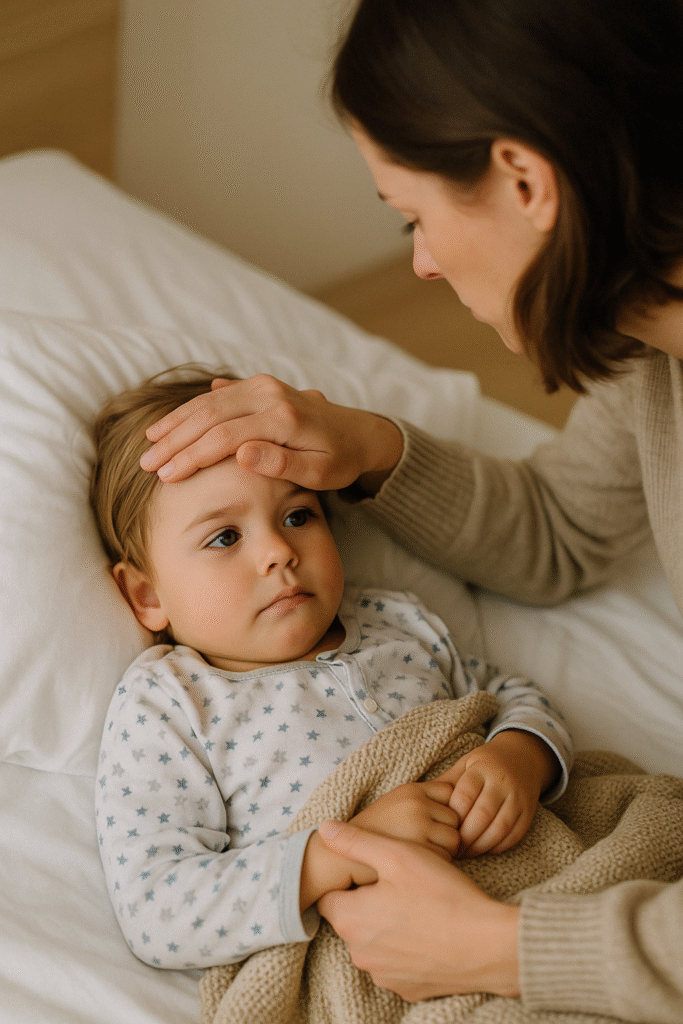
A helpful visual guide for Canadian parents

Introduction – skin rashes in toddlers
Skin rashes are extremely common in toddlers and can appear for a wide range of reasons — from mild irritation to more serious infections. For Canadian parents, especially first-timers, it can be stressful to see an unexpected skin change in a young child. Understanding the common types of rashes and what to look for can help you respond calmly and effectively.
This article provides an in-depth guide to help you recognize, understand, and respond to toddler skin rashes, with practical examples and when to call your doctor.
What Is a Rash?
A rash is any visible change in the skin’s color, texture, or appearance. In toddlers, it can present as red spots, bumps, dryness, or blistering. Some are itchy or painful, while others may cause no discomfort.
Rashes are not usually diseases in themselves — they are symptoms of other conditions such as infections, allergies, or skin sensitivity.
Common Skin Rashes in Toddlers
Below are some of the most common types of skin rashes Canadian parents may observe:
1. Diaper Rash
- Location: Genital area, buttocks, inner thighs
- Appearance: Red, irritated skin with possible small blisters or open sores
- Cause: Prolonged contact with wet or dirty diapers, yeast infections, or chafing
2. Eczema (Atopic Dermatitis)
- Location: Cheeks, scalp, elbows, knees
- Appearance: Dry, rough, scaly patches, often itchy
- Cause: Genetics, cold dry weather, allergens, soaps
3. Contact Dermatitis
- Location: Hands, face, or wherever an irritant touched the skin
- Appearance: Redness, swelling, or blisters
- Cause: Soaps, creams, detergents, plant exposure
4. Heat Rash (Prickly Heat)
- Location: Neck, chest, armpits
- Appearance: Tiny red or pink bumps
- Cause: Overheating, tight clothes, high humidity
5. Hives (Urticaria)
- Location: Anywhere on the body
- Appearance: Raised red welts that come and go
- Cause: Allergic reactions (food, meds, bug bites)
6. Viral Rash (Exanthem)
- Location: Widespread on torso, arms, legs
- Appearance: Flat or raised red spots, often after fever
- Cause: Viral infections (roseola, fifth disease)
How to Recognize and Track a Rash – skin rashes in toddlers
Ask yourself the following:
- Did the rash appear suddenly or gradually?
- Is it itchy or painful?
- Is your child running a fever?
- Is the rash spreading or localized?
- Has your child been in contact with new substances (soap, detergent, foods)?
- Is the child scratching or irritated?
Taking note of these details helps your doctor determine whether treatment is necessary.
When to Seek Medical Help
Call your healthcare provider or visit a clinic in Canada if:
- The rash is accompanied by a fever above 38.5°C
- The rash blisters, peels, or bleeds
- There is swelling of lips, eyes, or face
- The rash appears suddenly and spreads quickly
- It does not improve after 3–5 days of care
- It looks like bruises or purple spots (potential emergency)
For immediate guidance, you can contact Telehealth Ontario at 1-866-797-0000.
Home Treatment Tips – skin rashes in toddlers
For mild or non-contagious rashes:
- Use cool compresses to relieve itchiness
- Bathe your toddler in colloidal oatmeal or baking soda baths
- Apply unscented moisturizer twice daily (especially for eczema)
- Dress your child in soft, breathable fabrics
- Avoid scratching – keep nails short
- Apply hydrocortisone 0.5% cream if advised by your doctor
Avoid home remedies that include essential oils or unapproved topical treatments.
How to Prevent Future Rashes
- Choose hypoallergenic, fragrance-free detergents
- Use moisturizers, especially in cold Canadian winters
- Keep your toddler’s skin clean and dry
- Dress appropriately for the weather
- Avoid unnecessary use of baby powders and harsh soaps
Helpful Canadian Resources (Outbound Links)
- Caring for Kids – Skin Conditions in Children
- HealthLink BC – Skin Rashes in Children
- Telehealth Ontario (Free 24/7 Medical Advice)
Internal Link
Also read: How to Treat Ear Infections at Home
Conclusion
Most toddler rashes are not dangerous and can be managed safely at home. Still, knowing how to identify them and when to seek professional help gives parents peace of mind. In Canada, you also have access to trusted pediatric health resources when in doubt.
If you ever feel unsure, contact your family doctor or use Telehealth Ontario for expert guidance.
Disclaimer
This article is for informational purposes only and does not replace the advice of a qualified healthcare provider. Always consult your doctor regarding your child’s health.
👉 Want more expert care and health tips from trusted sources? Check Here.
Pingback: Top Baby Cereals in Canada for Nutrition and Taste - Maple Medica